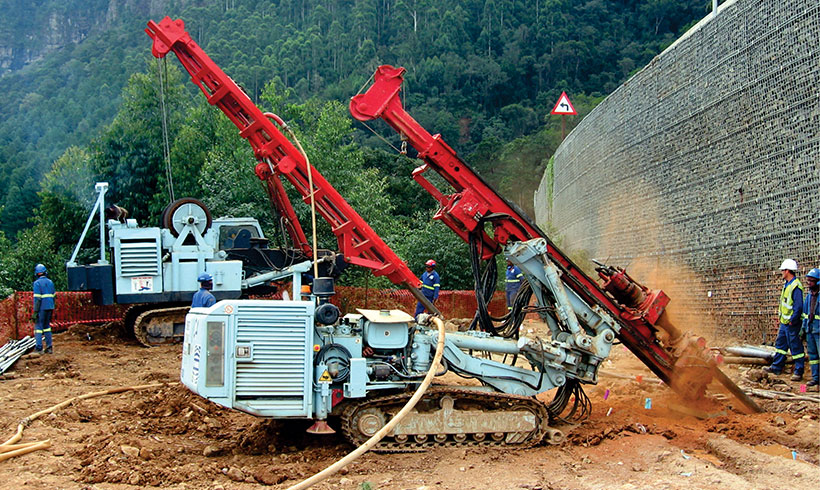Top Guidelines Of Geotechnical Engineering For Construction Projects
Top Guidelines Of Geotechnical Engineering For Construction Projects
Blog Article
The 3-Minute Rule for Geotechnical Engineering For Construction Projects
Table of ContentsThe Of Geotechnical Engineering For Construction ProjectsNot known Factual Statements About Geotechnical Engineering For Construction Projects Not known Facts About Geotechnical Engineering For Construction ProjectsNot known Incorrect Statements About Geotechnical Engineering For Construction Projects Some Known Factual Statements About Geotechnical Engineering For Construction Projects How Geotechnical Engineering For Construction Projects can Save You Time, Stress, and Money.
These features have to be taken a look at by geotechnical engineers to anticipate their movements under various circumstances., making this analysis essential.A geotechnical engineer will take a look at dirt to figure out the bearing capability of the earth and suggest proper structure types, such as superficial structures, deep foundations like heaps, or specialized remedies like drifting structures for soft soils. Recognizing the attributes and actions of dirt and rock, in enhancement to how they engage with buildings that have been put up on or within them, is among the key explanations for why geotechnical engineering is necessary.
Environmental defense is achieved with geotechnical engineering. Experience in air, water, and dirt high quality upkeep is put to make use of by geotechnical engineers to reduce the unfavorable effects of jobs.
Framework development, offshore engineering, tunnel construction, and deep structures. Risk-based style and multidisciplinary groups. These components will certainly maintain the area evolving and ensure its ongoing importance in the years to come. To sum up, geotechnical engineering is a crucial discipline that preserves the resilience and stability of civil framework. Geotechnical engineers add to making structure projects reliable throughout the globe by recognizing the practices of earth products and applying appropriate preparation approaches.
Get This Report on Geotechnical Engineering For Construction Projects
The fundamental security of any type of task is vital. Geotechnical design plays a critical function in guaranteeing that frameworks are developed on strong ground, literally and figuratively. By taking a look at soil, rock, and subsurface conditions, geotechnical engineers offer crucial understandings that aid in the layout, construction, and maintenance of buildings and facilities.

Geotechnical Engineering For Construction Projects Things To Know Before You Get This
Lab screening: Identifying the residential or commercial properties of dirt and rock. Several top-level building and construction projects have actually efficiently used geotechnical design to ensure their security and safety and security.

As a leader in geotechnical engineering, BECC Inc. is dedicated to providing innovative and efficient solutions that fulfill the highest criteria of quality and safety and security. For more details on just how BECC Inc. can support your following building project, call us today and allow us assist you improve strong ground.
William Rankine, a designer and physicist, established an alternative to Coulomb's planet pressure theory. Albert Atterberg created the clay consistency indices that are still made use of today for soil category. In 1885, Osborne Reynolds identified that shearing causes volumetric expansion of dense products and contraction of loose granular materials. Modern geotechnical engineering is claimed to have started in 1925 with the publication of Erdbaumechanik by Karl von Terzaghi, a mechanical engineer and rock hound.
What Does Geotechnical Engineering For Construction Projects Mean?
Terzaghi likewise created the framework for concepts of bearing capability of foundations, and the theory for forecast of the rate of negotiation of clay layers because of debt consolidation. Afterwards, Maurice Biot totally created the three-dimensional soil debt consolidation concept, expanding the one-dimensional version formerly developed by Terzaghi to more general hypotheses and introducing the set of fundamental formulas of Poroelasticity.
Geotechnical engineers check out and figure out the buildings of subsurface conditions and products.
The Ultimate Guide To Geotechnical Engineering For Construction Projects
Geologic see this here mapping and interpretation of geomorphology are commonly completed in consultation with a rock hound or design rock hound. Subsurface exploration generally entails in-situ testing (for example, the common infiltration examination and cone infiltration examination). The excavating of examination click for info pits and trenching (especially for situating mistakes and slide airplanes) might additionally be made use of to find out about soil problems at deepness. , which uses a thick-walled split spoon sampler, is the most typical means to collect disturbed samples.

If the user interface between the mass and the base of a slope has a complex geometry, incline he has a good point security analysis is difficult and numerical remedy approaches are required. Typically, the interface's exact geometry is unknown, and a simplified interface geometry is thought. Limited slopes require three-dimensional designs to be evaluated, so most inclines are examined presuming that they are infinitely large and can be represented by two-dimensional versions.
The Main Principles Of Geotechnical Engineering For Construction Projects
The observational technique might be referred to as adheres to: General exploration adequate to establish the rough nature, pattern, and residential properties of deposits. Evaluation of the most possible problems and one of the most negative imaginable discrepancies. Creating the design based on a working hypothesis of actions expected under one of the most potential problems. Choice of quantities to be observed as building and construction profits and computing their anticipated values based on the working theory under the most unfavorable conditions.
Dimension of amounts and evaluation of actual problems. Design modification per actual conditions The observational method is ideal for construction that has actually already begun when an unexpected growth happens or when a failure or mishap looms or has actually already taken place. It is improper for projects whose style can not be modified during construction.
Report this page